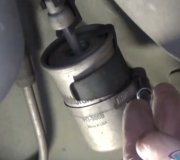There are three tests to perform when checking a mechanical fuelp pump. The volume, pressure and vacuum tests.
Since you aren't getting any fuel to the carb. We'll skip the volume test (it measures the amount of fuel coming out of the fuel line [and into a bottle] at the carb, during a 15 second period of engine cranking).
The vacuum test is important here. It checks the amount of suction the pump produces to pull the fuel from the gas tank.
To do this you'll need a vacuum guage which also reads pressure (your local auto part store has them and they aren't very expensive - worth the investment because it can be used for so many other tests, even to do a tune-up!) Disable the ignition system (for safety).
Disconnect the fuel supply line from the fuel pump. Connect the vacuum gauge line to the suction (fuel supply) side of the fuel pump.(If this proves difficult, you can hold the rubber vacuum gauge hose in the supply side of the fuel pump). Have a partner to spin the engine over for about 15 seconds. Note the highest vacuum reading. Should be 15 to 20 in. Hg.
The pressure test is performed onthe outlet side of the fuel pump.
Disconnet the line which goes to the carburetor (at the fuel pump). Attach the vacuum/pressure gauge oto that outlet (or hold it by hand if necessary). Have you partnet to spin the engine for about 15 seconds and note the highest pressure reading. Should be 4 to 7 PSI.
If the fuel pump fails either of these tests, replace it.
Sunday, July 7th, 2013 AT 7:38 PM



